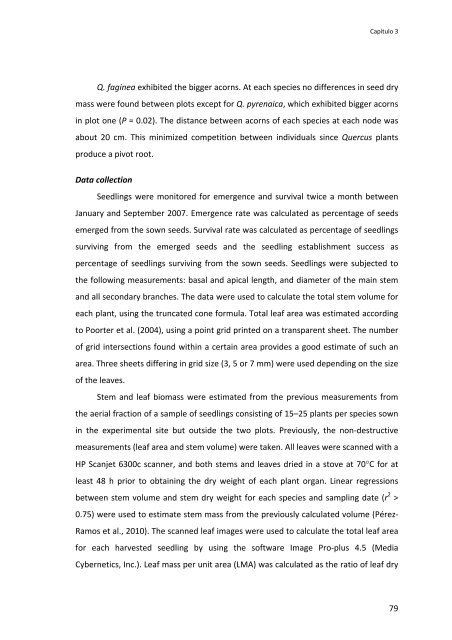Establecimiento de cuatro especies de Quercus en el sur de la ...
Establecimiento de cuatro especies de Quercus en el sur de la ...
Establecimiento de cuatro especies de Quercus en el sur de la ...
Create successful ePaper yourself
Turn your PDF publications into a flip-book with our unique Google optimized e-Paper software.
Capítulo 3<br />
Q. faginea exhibited the bigger acorns. At each species no differ<strong>en</strong>ces in seed dry<br />
mass were found betwe<strong>en</strong> plots except for Q. pyr<strong>en</strong>aica, which exhibited bigger acorns<br />
in plot one (P = 0.02). The distance betwe<strong>en</strong> acorns of each species at each no<strong>de</strong> was<br />
about 20 cm. This minimized competition betwe<strong>en</strong> individuals since <strong>Quercus</strong> p<strong>la</strong>nts<br />
produce a pivot root.<br />
Data collection<br />
Seedlings were monitored for emerg<strong>en</strong>ce and <strong>sur</strong>vival twice a month betwe<strong>en</strong><br />
January and September 2007. Emerg<strong>en</strong>ce rate was calcu<strong>la</strong>ted as perc<strong>en</strong>tage of seeds<br />
emerged from the sown seeds. Survival rate was calcu<strong>la</strong>ted as perc<strong>en</strong>tage of seedlings<br />
<strong>sur</strong>viving from the emerged seeds and the seedling establishm<strong>en</strong>t success as<br />
perc<strong>en</strong>tage of seedlings <strong>sur</strong>viving from the sown seeds. Seedlings were subjected to<br />
the following mea<strong>sur</strong>em<strong>en</strong>ts: basal and apical l<strong>en</strong>gth, and diameter of the main stem<br />
and all secondary branches. The data were used to calcu<strong>la</strong>te the total stem volume for<br />
each p<strong>la</strong>nt, using the truncated cone formu<strong>la</strong>. Total leaf area was estimated according<br />
to Poorter et al. (2004), using a point grid printed on a transpar<strong>en</strong>t sheet. The number<br />
of grid intersections found within a certain area provi<strong>de</strong>s a good estimate of such an<br />
area. Three sheets differing in grid size (3, 5 or 7 mm) were used <strong>de</strong>p<strong>en</strong>ding on the size<br />
of the leaves.<br />
Stem and leaf biomass were estimated from the previous mea<strong>sur</strong>em<strong>en</strong>ts from<br />
the aerial fraction of a sample of seedlings consisting of 15–25 p<strong>la</strong>nts per species sown<br />
in the experim<strong>en</strong>tal site but outsi<strong>de</strong> the two plots. Previously, the non‐<strong>de</strong>structive<br />
mea<strong>sur</strong>em<strong>en</strong>ts (leaf area and stem volume) were tak<strong>en</strong>. All leaves were scanned with a<br />
HP Scanjet 6300c scanner, and both stems and leaves dried in a stove at 70°C for at<br />
least 48 h prior to obtaining the dry weight of each p<strong>la</strong>nt organ. Linear regressions<br />
betwe<strong>en</strong> stem volume and stem dry weight for each species and sampling date (r 2 ><br />
0.75) were used to estimate stem mass from the previously calcu<strong>la</strong>ted volume (Pérez‐<br />
Ramos et al., 2010). The scanned leaf images were used to calcu<strong>la</strong>te the total leaf area<br />
for each harvested seedling by using the software Image Pro‐plus 4.5 (Media<br />
Cybernetics, Inc.). Leaf mass per unit area (LMA) was calcu<strong>la</strong>ted as the ratio of leaf dry<br />
79

















